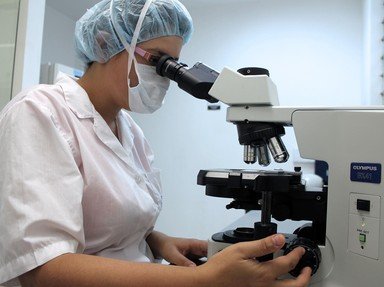Quiz Answer Key and Fun Facts
1. Let's talk about the cell cycle! As its name suggests, this cycle is a very generally applicable one, which in its broad outlines is common to just about every living cell. In cells with nuclei, the division phase of the cell cycle is called mitosis. Which of the following statements about mitosis is true, if everything goes right?
2. Mitosis is probably the most exciting part of the eukaryotic cell cycle, but it doesn't take up a very long time in the life of a cell. What's the name of the longest phase of the cell cycle?
3. Where do cells get their energy, anyway? Ultimately, almost all that fuel comes from sunlight, which is converted to food via photosynthesis. In a typical photosynthetic reaction, a plant cell might produce sugars, oxygen, and water, starting from only a few raw materials: water, sunlight, and what else?
4. Photosynthesis is a highly specialized process. Not just anyone can do it - in fact, no animals whatsoever can - and, even in a photosynthetic organism, it doesn't happen just anywhere. What's the name of the organelle that performs photosynthesis in plant cells?
5. In the second stage of photosynthesis, often called the Calvin cycle, stored energy from sunlight powers the transformation of water and carbon dioxide into organic compounds. What's another name for this accomplishment?
6. Cells need energy to function, and a popular process for converting sugars to a usable fuel source is called cellular respiration. There are two main ways to go about this: anaerobic respiration and aerobic respiration. What is the difference between them?
7. Let's take a closer look at aerobic respiration. A cyclical process drives much of the energy production here. Two molecules of water and an acetate molecule - acetyl-CoA - go into the cycle; carbon dioxide, NADH, and reduced ubiquinone come out. Which of these names refers to this cycle?
8. Not all cells make energy via cellular respiration: some use fermentation instead. Which of these is NOT a product of fermentation, if we count glycolysis as part of the process?
9. For cells with nuclei - eukaryotes - sexual reproduction relies on a process called meiosis, but a mistake in that process will result in a genetic condition that may be fatal. In humans, three such conditions are Klinefelter Syndrome, Triple X Syndrome, and Turner Syndrome; what do they have in common?
10. Meiosis begins with a single, eukaryotic, diploid cell - that is, a cell with a nucleus that has two copies of each chromosome - and ends up with four of what kind of cell?
Source: Author
CellarDoor
This quiz was reviewed by FunTrivia editor
gtho4 before going online.
Any errors found in FunTrivia content are routinely corrected through our feedback system.

